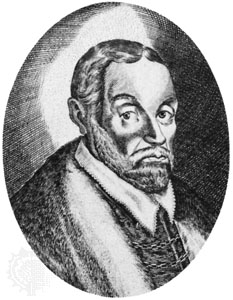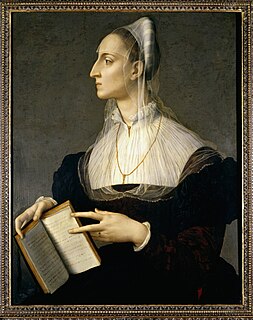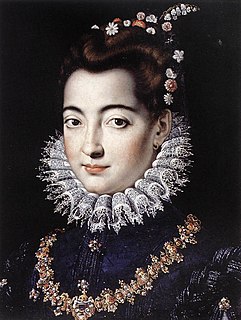
Maddalena Campiglia (April 13, 1553 - January 28, 1595) was an Italian poet. She is remembered for being praised by Torquato Tasso for the composition of the pastoral fable Flori, inspired by Aminta. [1]

Maddalena Campiglia (April 13, 1553 - January 28, 1595) was an Italian poet. She is remembered for being praised by Torquato Tasso for the composition of the pastoral fable Flori, inspired by Aminta. [1]
Maddalena Campiglia was born in Vicenza on April 13, 1553, an illegitimate child of Polissena Verlato and Carlo Campiglia. Both nobles and widowers, parents of two sons older than Maddalena, the two regularized their union only in 1565. [2]
During her studies, the young Campiglia showed particular interest in literature, philosophy and music. [3] Also important for her intellectual development was the attendance of the cultural society of the 16th century that met in the province of Vicenza at the villa owned by her cousin Elena, married to the Marquis Guido Sforza Gonzaga. Here she met: Curzio Gonzaga, Marquis of Palazzolo, poet and diplomat, a friend of writers and artists, who gained Campiglia's trust to the point of being designated by her in the will as curator of her writings; Bernardino Baldi and Torquato Tasso. [4] [2]
Presumably at the villa Gonzaga she met Dionisio da Colzè (or Calzé) whom she married in 1576; the marriage lasted till 1580, the year in which she separated and began to live alone. There was, by imposition of Campiglia, a white marriage, [5] as can be deduced from the acts of separation from which it can also be understood her lack of predisposition towards motherhood. [2]
In 1580 it also began her literary production, with writings of a religious nature in which, however, the nonconformist spirit was already visible. According to Campiglia, virginity had to be lived not as a constraint but as an effective means of achieving female independence from the male gender. As incarnation par excellence of this principle, she indicated the Virgin Mary who, according to her, had spontaneously voted for chastity and because of the greatness of this choice she had been chosen by God. She expressed this concept in "Discorso intorno all'Annunciazione della Vergine", printed in Vicenza in 1585. [2]
The most recognized work of Campiglia was Flori, a "boscareccia" fable inspired by the Aminta of Torquato Tasso that earned her the compliments of the poet himself. It was printed in Vicenza in 1588 and it was dedicated to Curzio Gonzaga. Flori is a virgin nymph devoted to the cult of Diana, who, struck by the death of her beloved friend Amaranta, despite the love of her girlfriend Licori, is destined to fall in love with the first man she meets. Although in love with the shepherd who meets the nymph, she accepts only a chaste marriage. [2]
In addition to the theme of virginity, in this work is introduced another delicate theme, the love between women. This topic finds its maximum expression in the meaning of the phrase "Donna amando pur Donna essendo" (Loving a woman despite being a woman).
In 1589 she published Calisa. Two shepherds, Edreo and Clori, celebrated the marriage of Lico, son of Calisa, with Bice. In real life Calisa is Isabella Pallavicini Lupi, marquise of Soragna, protector of Campiglia, to whom Calisa and numerous other sonnets are dedicated. [2]
After 1589, Campiglia, already affected by the illness that would kill her, did not publish independent works. Some of her sonnets appeared in other collections (Rime by A. Grillo (1589) and Rime by O. Zambrini (1594)). [2]
Maddalena Campiglia died in Vicenza on January 28, 1595, following a long illness that deprived her of sight. In her last years, Campiglia approached the monastic environments and became a terziaria of San Domenico and in her will she requested to be buried in the same sepulcher of the Abbesses Giulia Cisotta, near the church of Santa Maria d'Araceli in Vicenza. [2]

Torquato Tasso was an Italian poet of the 16th century, known for his poem Gerusalemme liberata, in which he depicts a highly imaginative version of the combats between Christians and Muslims at the end of the First Crusade, during the Siege of Jerusalem.
This article presents lists of literary events and publications in the 16th century.

Giovanni Battista Guarini was an Italian poet, dramatist, and diplomat.
Giaches de Wert was a Franco-Flemish composer of the late Renaissance, active in Italy. Intimately connected with the progressive musical center of Ferrara, he was one of the leaders in developing the style of the late Renaissance madrigal. He was one of the most influential of late sixteenth-century madrigal composers, particularly on Claudio Monteverdi, and his later music was formative on the development of music of the early Baroque era.

Il re pastore is an opera, K. 208, written by Wolfgang Amadeus Mozart to an Italian libretto by Metastasio, edited by Giambattista Varesco. It is an opera seria. The opera was first performed on 23 April 1775 in Salzburg in the Rittersaal of the Residenz-Theater in the palace of the Archbishop Count Hieronymus von Colloredo.

Penelope Rich, Lady Rich, later styled Penelope Blount was an English court office holder. She served as lady-in-waiting to the English queen Anne of Denmark. She was the sister of Robert Devereux, 2nd Earl of Essex, and is traditionally thought to be the inspiration for "Stella" of Sir Philip Sidney's Astrophel and Stella sonnet sequence. She married Robert Rich, 3rd Baron Rich and had a public liaison with Charles Blount, Baron Mountjoy, whom she married in an unlicensed ceremony following her divorce from Rich. She died in 1607.

Isabella Andreini, also known as Isabella Da Padova, was an Italian actress and writer. Considered beautiful, elegant, and well educated, she was one of the most famous performers of her time. Isabella Andreini was a member of the Compagnia dei Comici Gelosi, an influential touring theatre company that performed for the highest social circles of Italy and France. Famous in her time, and distinguished both for her acting and her character, the role of Isabella of the commedia dell'arte was named after her.

Virginia de' Medici was an Italian princess, a member of the House of Medici and by marriage Duchess of Modena and Reggio.

Aminta is a play written by Torquato Tasso in 1573, represented during a garden party at the court of Ferrara. Both the actors and the public were noble persons living at the Court, who could understand subtle allusions the poet made to that style of life, in contrast with the life of shepherds, represented in an idyllic way.
Thomas Watson (1555–1592) was an English poet and translator, and the pioneer of the English madrigal. His lyrics aside, he wrote largely in Latin, also being the first to translate Sophocles' Antigone from the Greek. His incorporation of Italianate forms into English lyric verse influenced a generation of English writers, including Shakespeare, who was referred to in 1595 by William Covell as "Watson's heyre" (heir). He wrote both English and Latin compositions, and was particularly admired for the Latin. His unusual 18-line sonnets were influential, although the form was not generally imitated.

Margherita Barbara Gonzaga, was an Italian noblewoman, a member of the House of Gonzaga and by marriage Duchess consort of Ferrara, Modena and Reggio during 1579–1597.

Barbara of Austria, was an Archduchess of Austria as a member of the House of Habsburg and by marriage Duchess consort of Ferrara, Modena and Reggio during 1565–1572.

Amoretti is a sonnet cycle written by Edmund Spenser in the 16th century. The cycle describes his courtship and eventual marriage to Elizabeth Boyle.

Lucrezia de' Medici, was a member of the House of Medici and by marriage Duchess consort of Ferrara, Modena and Reggio during 1558–1561.

For other women of the same name, see Eleanor Gonzaga (disambiguation)
Max Wickert is a German-American teacher, poet, translator and publisher. He is Professor of English Emeritus at the University at Buffalo

Laura Battiferri (1523–1589), also called Laura Battiferri Ammannati, was an Italian poet during the Renaissance period. She was born in Urbino, Marche, Italy as the illegitimate daughter of Giovanni Antonio Battiferri from Urbino and Maddalena Coccapani from Carpi, Emilia-Romagna. She published two books of poetry: The First Book of Tuscan Works and The Seven Penitential Psalms… with some Spiritual Sonnets. She died in 1589 while compiling a third, Rime, which was never published. She married the sculptor, Bartolomeo Ammannati in 1550 and they remained married until her death and they had no children.
Jean Fleming, Countess of Cassilis (1553/4–1609) was a Scottish noblewoman and courtier at the court of James VI of Scotland, and a victim of domestic violence.
Nicoletta Pasquale, known also as Coletta Pasquale or Paschale was an Italian poet.

Clelia Farnese, was an Italian noblewoman member of the House of Farnese and by her two marriages Marchioness of Civitanova and Lady of Sassuolo. According to contemporaries, she was one of the most beautiful women of her time.